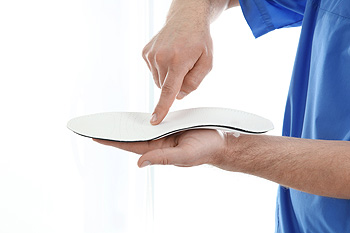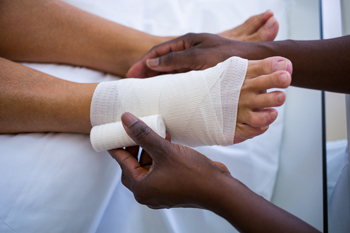
Many people familiar with podiatry might already know what orthotics are. These custom-made or over-the-counter foot devices are essentially shoe inserts. They can be used to correct foot deformities, facilitate healing, or simply provide extra support. Senior adults are a particular group of individuals that might especially benefit from the use of orthotic devices. The reason for this is simple. Ultimately, using certain orthotic devices as a senior can actually improve one’s sense of balance and stability. This can be very useful and beneficial concerning how dangerous suffering from falls can be for seniors. Balance-inducing orthotic devices can help seniors mitigate the effects of muscle weakness, joint instability, and gait abnormalities. If you are a senior or are caring for one, it is suggested that you schedule an appointment with a podiatrist today to discuss the potential benefits of orthotic devices.
If you are having discomfort in your feet and would like to try orthotics, contact Howard Waxman, DPM from Pleasant Valley Podiatry. Our doctor can provide the care you need to keep you pain-free and on your feet.
What Are Orthotics?
Orthotics are inserts you can place into your shoes to help with a variety of foot problems such as flat feet or foot pain. Orthotics provide relief and comfort for minor foot and heel pain but can’t correct serious biomechanical problems in your feet.
Over-the-Counter Inserts
Orthotics come in a wide variety of over-the-counter inserts that are used to treat foot pain, heel pain, and minor problems. For example, arch supports can be inserted into your shoes to help correct overarched or flat feet, while gel insoles are often used because they provide comfort and relief from foot and heel pain by alleviating pressure.
Prescription Orthotics
If over-the-counter inserts don’t work for you or if you have a more severe foot concern, it is possible to have your podiatrist prescribe custom orthotics. These high-quality inserts are designed to treat problems such as abnormal motion, plantar fasciitis, and severe forms of heel pain. They can even be used to help patients suffering from diabetes by treating foot ulcers and painful calluses and are usually molded to your feet individually, which allows them to provide full support and comfort.
If you are experiencing minor to severe foot or heel pain, it’s recommended to speak with your podiatrist about the possibilities of using orthotics. A podiatrist can determine which type of orthotic is right for you and allow you to take the first steps towards being pain-free.
If you have any questions please contact one of our offices located in Willoughby Hills and Broadview Heights, OH . We offer the newest diagnostic and treatment technologies for all your foot and ankle needs.

An Achilles tendon injury can cause severe pain and discomfort, and it may be difficult to walk. This tendon connects the calf muscles to the heel, which can become injured for various reasons. It is considered to be the strongest tendon in the body, and provides the ability to walk, run, and jump. A common reason for this type of injury to occur can be from increasing speed and distance too quickly while running, or from experiencing a trauma. This can consist of getting a deep cut over the tendon, possibly causing it to tear. Additionally, people who do not warm up and cool down properly before and after exercising may be prone to developing an Achilles tendon injury. Taking certain antibiotics, and becoming older may also lead to having this injury. Relief may be found when the foot is frequently elevated, and the activity that caused the pain is temporarily stopped. If you have this type of affliction, it is suggested that you contact a podiatrist who can effectively treat an Achilles tendon injury.
Achilles tendon injuries need immediate attention to avoid future complications. If you have any concerns, contact Howard Waxman, DPM of Pleasant Valley Podiatry. Our doctor can provide the care you need to keep you pain-free and on your feet.
What Is the Achilles Tendon?
The Achilles tendon is a tendon that connects the lower leg muscles and calf to the heel of the foot. It is the strongest tendon in the human body and is essential for making movement possible. Because this tendon is such an integral part of the body, any injuries to it can create immense difficulties and should immediately be presented to a doctor.
What Are the Symptoms of an Achilles Tendon Injury?
There are various types of injuries that can affect the Achilles tendon. The two most common injuries are Achilles tendinitis and ruptures of the tendon.
Achilles Tendinitis Symptoms
Rupture Symptoms
Treatment and Prevention
Achilles tendon injuries are diagnosed by a thorough physical evaluation, which can include an MRI. Treatment involves rest, physical therapy, and in some cases, surgery. However, various preventative measures can be taken to avoid these injuries, such as:
If you have any questions please feel free to contact one of our offices located in Willoughby Hills and Broadview Heights, OH . We offer the newest diagnostic tools and technology to treat your foot and ankle needs.

Many people have endured injuries that leave wounds, and this can often affect the feet. Practicing good wound care techniques is essential in having the wound heal properly. Many wounds require the dressing to be changed several times per week, and it is helpful to follow specific procedures to ensure that this is properly done. It can begin with having a bag close by in which the old dressing and gloves can be disposed of. The wound is then cleaned by washing it with lukewarm water. This is followed by applying the new dressing, and making sure it completely covers the wound. If the wound emits an odor, or if the skin surrounding it becomes red and heated, it is suggested that you consult with a podiatrist who can guide you on correct wound care treatment.
Wound care is an important part in dealing with diabetes. If you have diabetes and a foot wound or would like more information about wound care for diabetics, consult with Howard Waxman, DPM from Pleasant Valley Podiatry. Our doctor will assess your condition and provide you with quality foot and ankle treatment.
What Is Wound Care?
Wound care is the practice of taking proper care of a wound. This can range from the smallest to the largest of wounds. While everyone can benefit from proper wound care, it is much more important for diabetics. Diabetics often suffer from poor blood circulation which causes wounds to heal much slower than they would in a non-diabetic.
What Is the Importance of Wound Care?
While it may not seem apparent with small ulcers on the foot, for diabetics, any size ulcer can become infected. Diabetics often also suffer from neuropathy, or nerve loss. This means they might not even feel when they have an ulcer on their foot. If the wound becomes severely infected, amputation may be necessary. Therefore, it is of the upmost importance to properly care for any and all foot wounds.
How to Care for Wounds
The best way to care for foot wounds is to prevent them. For diabetics, this means daily inspections of the feet for any signs of abnormalities or ulcers. It is also recommended to see a podiatrist several times a year for a foot inspection. If you do have an ulcer, run the wound under water to clear dirt from the wound; then apply antibiotic ointment to the wound and cover with a bandage. Bandages should be changed daily and keeping pressure off the wound is smart. It is advised to see a podiatrist, who can keep an eye on it.
If you have any questions, please feel free to contact one of our offices located in Willoughby Hills and Broadview Heights, OH . We offer the newest diagnostic and treatment technologies for all your foot care needs.

Athlete’s foot can be extremely uncomfortable. It is a foot condition that is caused by a fungal infection of the skin, and generally affects the toes and soles of the feet. The fungus that causes this condition lives in warm and moist environments, such as shower room floors and public swimming pools. Because the fungus is contagious, it is beneficial to wear appropriate shoes while in these types of areas. Additionally, it is wise to refrain from sharing shoes, towels, and socks, as this may help to limit the spread of athlete’s foot. Research has indicated there are two types of athlete’s foot fungus. Trichophyton rubrum is classified as long-lasting and may often be recurring. Trichophyton mentagrophytes is a type of fungus that is found between the toes and is treatable, despite its severity. If you have itchy skin on your feet, it is suggested that you confer with a podiatrist who can properly diagnose and treat athlete’s foot.
Athlete’s foot is an inconvenient condition that can be easily reduced with the proper treatment. If you have any concerns about your feet and ankles, contact Howard Waxman, DPM from Pleasant Valley Podiatry. Our doctor will treat your foot and ankle needs.
Athlete’s Foot: The Sole Story
Athlete's foot, also known as tinea pedis, can be an extremely contagious foot infection. It is commonly contracted in public changing areas and bathrooms, dormitory style living quarters, around locker rooms and public swimming pools, or anywhere your feet often come into contact with other people.
Solutions to Combat Athlete’s Foot
Athlete’s foot can cause many irritating symptoms such as dry and flaking skin, itching, and redness. Some more severe symptoms can include bleeding and cracked skin, intense itching and burning, and even pain when walking. In the worst cases, Athlete’s foot can cause blistering as well. Speak to your podiatrist for a better understanding of the different causes of Athlete’s foot, as well as help in determining which treatment options are best for you.
If you have any questions please feel free to contact one of our offices located in Willoughby Hills and Broadview Heights, OH . We offer the newest diagnostic and treatment technologies for all your foot and ankle needs.